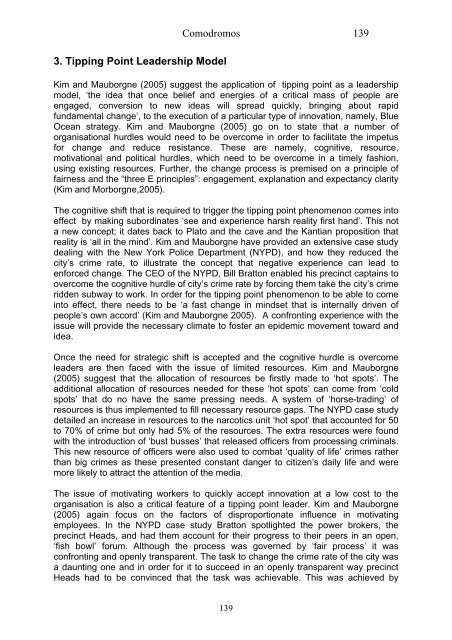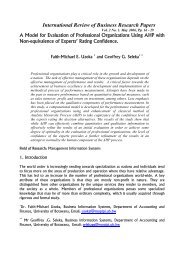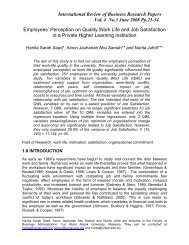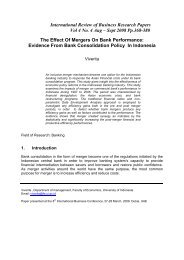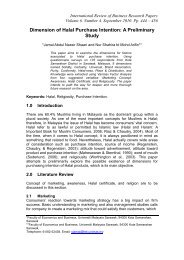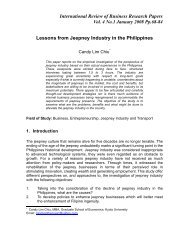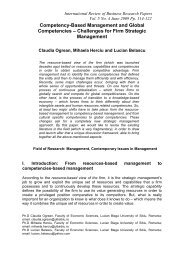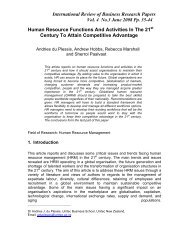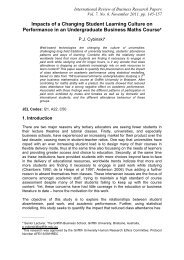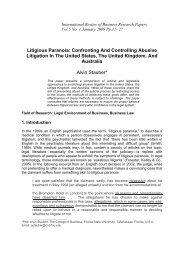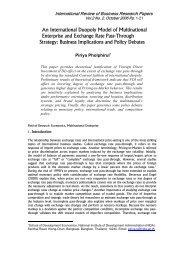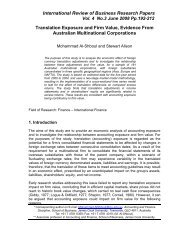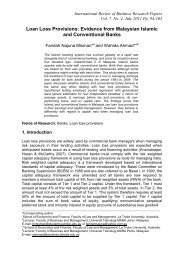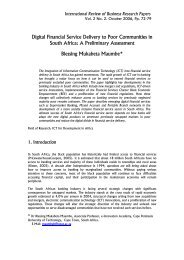Tipping Point Leadership And Its Relationship To Transformational
Tipping Point Leadership And Its Relationship To Transformational
Tipping Point Leadership And Its Relationship To Transformational
Create successful ePaper yourself
Turn your PDF publications into a flip-book with our unique Google optimized e-Paper software.
3. <strong>Tipping</strong> <strong>Point</strong> <strong>Leadership</strong> ModelComodromos 139Kim and Mauborgne (2005) suggest the application of tipping point as a leadershipmodel, ‘the idea that once belief and energies of a critical mass of people areengaged, conversion to new ideas will spread quickly, bringing about rapidfundamental change’, to the execution of a particular type of innovation, namely, BlueOcean strategy. Kim and Mauborgne (2005) go on to state that a number oforganisational hurdles would need to be overcome in order to facilitate the impetusfor change and reduce resistance. These are namely, cognitive, resource,motivational and political hurdles, which need to be overcome in a timely fashion,using existing resources. Further, the change process is premised on a principle offairness and the “three E principles”: engagement, explanation and expectancy clarity(Kim and Morborgne,2005).The cognitive shift that is required to trigger the tipping point phenomenon comes intoeffect by making subordinates ‘see and experience harsh reality first hand’. This nota new concept; it dates back to Plato and the cave and the Kantian proposition thatreality is ‘all in the mind’. Kim and Mauborgne have provided an extensive case studydealing with the New York Police Department (NYPD), and how they reduced thecity’s crime rate, to illustrate the concept that negative experience can lead toenforced change. The CEO of the NYPD, Bill Bratton enabled his precinct captains toovercome the cognitive hurdle of city’s crime rate by forcing them take the city’s crimeridden subway to work. In order for the tipping point phenomenon to be able to comeinto effect, there needs to be ‘a fast change in mindset that is internally driven ofpeople’s own accord’ (Kim and Mauborgne 2005). A confronting experience with theissue will provide the necessary climate to foster an epidemic movement toward andidea.Once the need for strategic shift is accepted and the cognitive hurdle is overcomeleaders are then faced with the issue of limited resources. Kim and Mauborgne(2005) suggest that the allocation of resources be firstly made to ‘hot spots’. Theadditional allocation of resources needed for these ‘hot spots’ can come from ‘coldspots’ that do no have the same pressing needs. A system of ‘horse-trading’ ofresources is thus implemented to fill necessary resource gaps. The NYPD case studydetailed an increase in resources to the narcotics unit ‘hot spot’ that accounted for 50to 70% of crime but only had 5% of the resources. The extra resources were foundwith the introduction of ‘bust busses’ that released officers from processing criminals.This new resource of officers were also used to combat ‘quality of life’ crimes ratherthan big crimes as these presented constant danger to citizen’s daily life and weremore likely to attract the attention of the media.The issue of motivating workers to quickly accept innovation at a low cost to theorganisation is also a critical feature of a tipping point leader. Kim and Mauborgne(2005) again focus on the factors of disproportionate influence in motivatingemployees. In the NYPD case study Bratton spotlighted the power brokers, theprecinct Heads, and had them account for their progress to their peers in an open,‘fish bowl’ forum. Although the process was governed by ‘fair process’ it wasconfronting and openly transparent. The task to change the crime rate of the city wasa daunting one and in order for it to succeed in an openly transparent way precinctHeads had to be convinced that the task was achievable. This was achieved by139


